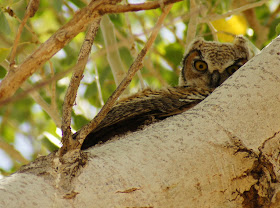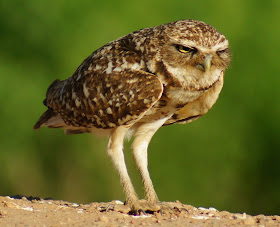It's been a whirlwind of busy these last couple weeks. With school drawing to close and evaluations due, there's been little time to tend the bird blog, which is no fair at all. Being unable to post for a while, I now have a serious backlog of photos, all of which were taken at Tres Rios. I've cooed about the biodiversity at Tres Rios many times before, and as I've been reviewing these photos, it's really been driven home that, perhaps on par with the Gilbert Water Ranch, the Tres Rios wetlands are one of the best diverse birding spots in the Phoenix metropolitan area.
Tres Rios has the normal panoply of riparian birds. Green Herons, Blue Herons, Big Herons, Small Herons, Bittern Herons, Black-Crowned Herons, and even Big White Herons, which we here in Arizona call Great Egrets, can all be found along the Tres Rios marshes.
The Great Blue Herons are definitely the most numerous. They have roosting colonies set up all throughout the 3 mile Tres Rios stretch, and often stare down, condescendingly, upon the puny mortals walking below. In fact, sometimes they resemble the American Gothic painting with their stern and serious poses.
The water works at Tres Rios are predictably flanked by cottonwood trees. These shady bastions are very welcome perches for other large birds and raptors that stay and endure the summer heat. This Red-Tailed Hawk would not endure my presence though, and took off immediately. To be fair, I've been told time and again that it's rude to stare. With birds, it's just so darn tempting...
Bald Eagles, Peregrine Falcons, Harris's Hawks, Kestrels, and Cooper's Hawks can all turn up in the canopies, and there are often surprises too. About three weeks ago I came across this pair of Great Horned Owl chicks. They were each sitting in separate cottonwoods, neither of which had a nest nearby. They didn't move while I was around, so they still trusted in their camouflage better than their flying skills.
This second chick weirded me out a little bit. Look hard at his face. His beak looks more like a koala bear nose, and some of the feathers on his face form a creepy little smile. He looked like he was contemplating all the different and delicious ways he would capture and eat me when he gets a little bit bigger.
I feel like I left a little piece of my soul lying somewhere, out there in the wilderness where I looked into this evil owl's eyes. We take great risks as birders, greater than any lion-tamer or shark-wrestler or active volcano-bungee jumper that I've ever met.
This past Friday I returned to Tres Rios with Pops and we saw three different Great Horned Owls flying around. At first I thought one was a Short-Eared Owl, since it's tufts were very small and it wasn't big enough to be a full-sized Great Horned. Soon we realized that these smaller Owls were the fledglings, now spreading their wings and beginning to terrorize the terrestrial population.
Like any successful restaurant, bar, or birding site, Tres Rios has its regulars, and plenty of them. However, its reputation extends pretty far, and lots of other summer residents and migratory birds come in for a visit during the spring. The regular birds are a foundation for great birding, but the excitement of migrants and other unusual visitors really keeps the birders coming back.
Let me know if I'm off here, but I'm pretty sure this super yellow nine inch bird is a Brown-Crested Flycatcher. (*Editor's note* Apparently I was way off here, and this is, in fact, also a Dusky-Capped Flycatcher) When Maria and I arrived at this spot, his perch was first being used by a Dusky-capped Flycatcher. As soon as the Dusky-capped flew off this Brown-Crsted flew in, as if he had been waiting his turn for some time. He must've been disappointed, because he only stayed for a minute and then also departed. His spot was immediately taken by a Mourning Dove, and at that point we moved on.

This spring I've also seen Tropical Kingbirds, Western Kingbirds, Willow Flycatchers, Cordilleran, Pacific-Slope, and Western Wood Pewees. It's been great to have so many different Flycatchers around, and not just because they keep the insect populations under control.

Other summer residents include Lucy's Warblers, along with Bullock's and Hooded Orioles. It is one of the less discussed phenomena of the birding world that Lucy's Warblers have the ability to make their features blurry, much like Sasquatch. Unlike Sasquatch, they can still be diagnostically identified by the grey body and little plum spots on their head and rump.

Then there are birds like this Indigo Bunting. This was my first confirmed sighting of these magnificent birds, and it was quite a surprise. Lazuli Buntings are a fairly common site at the preserve. Like some of the warblers, they're mostly moving up north. I have no idea what this Indigo Bunting is planning. The bird books don't show them as migrating through or residing in much of Arizona, but that's not a lot to go on these days. The Cornell website shows them as summer residents, but I haven't seen them anywhere else in central Arizona nor heard any other reports--and this bird is a real head-turner. Whatever he decides to do, it doesn't matter to me. When you look this good, you do whatever you want.

Unusual birds like the Indigo Bunting still make for an easy identification, but Pops and I have had a few mystery sightings at Tres Rios too. The swampy scrub grass draws in a lot of the little brown jobs. Song Sparrows are always in concert, and Lark, Lincoln, Vesper, and Brewer's Sparrows often join the cacophony. Soon after seeing the owl fledglings on Friday, Pops and I heard the distinct song of a Cassin's Sparrow somewhere in the ruff. We couldn't get a clear visual, but there were a few other Sparrows around--not necessarily the ones singing--that weren't easily identifiable either.
Here is the ambiguous culprit of the Cassin's song. This is a rare, rufous-morph of Cassin's Sparrow, which is already an unusual bird to find in the Phoenix area. It's a drab bird but still a pretty exciting find.
I'm pretty set on the ID of this last bird. It's a Pygmy Ostrich yes?
To visit Tres Rios is to treat oneself to a bricolage of birds, a feathered frenzy, a glamourous gallimaufry, a singing smorgasbord, a musical mélange. I highly recommend it.



















































